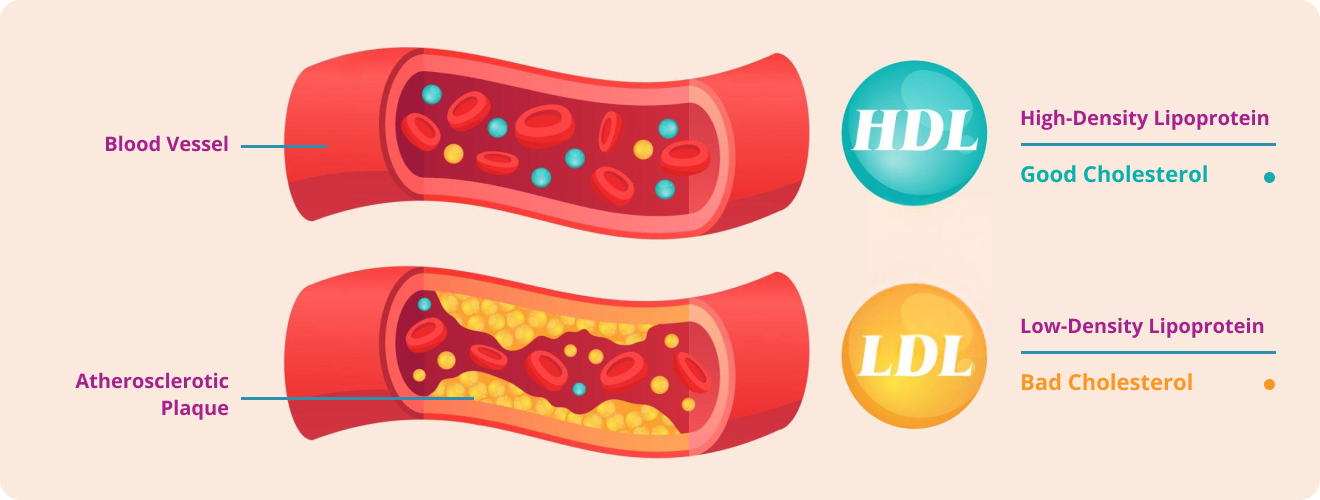


Cholesterol is a fatty, wax-like substance present in every cell of your body. It plays a crucial role in several important functions, such as forming healthy cells, producing hormones, and helping your body make vitamin D. Despite its crucial roles, cholesterol often gets a bad reputation, largely due to its association with heart disease. However, not all cholesterol is created equal, and understanding the different types and how they impact your cardiovascular health is paramount.
In Malaysia, heart and circulatory diseases remain a leading cause of disability and death, with high cholesterol being a significant modifiable risk factor. This article will decode the numbers, explain the distinctions between “good” and “bad” cholesterol, highlight the risk factors for high levels, and provide practical, healthy choices to manage your cholesterol for a healthier heart.
Cholesterol is a type of lipid, a fatty substance that’s carried in the blood by lipoproteins. These lipoproteins are like tiny vehicles that transport cholesterol to and from cells. Your body produces all the cholesterol it needs in the liver, but you also get some from the foods you eat, particularly animal products.
How does cholesterol affect your heart? What are the types of cholesterol? Which cholesterol is bad for the heart? Let us discuss the answers to these questions in detail in subsequent sections.

The distinction between “good” and “bad” cholesterol is crucial for understanding its impact on heart health:
Let’s take a look at the symptoms of cholesterol in the heart and how can they be monitored.
Regular cholesterol checks are a vital part of routine health screenings, typically involving a blood test after a 9 to 12-hour fast. Your results will usually show levels of total cholesterol, LDL, HDL, and triglycerides. While target ranges can vary slightly based on individual risk factors, general guidelines suggest:
| Total Cholesterol | LDL Cholesterol | HDL Cholesterol | Triglycerides |
|---|---|---|---|
| Ideally, below 5 mmol/L (millimoles per litre). | Ideally, below 3 mmol/L. For those with existing heart disease or high risk, even lower targets (e.g., below 1.8 mmol/L) may be advised. | Ideally, above 1 mmol/L. The higher, the better. | Ideally, below 2.3 mmol/L. |
It is important to discuss your specific results with your doctor, as they will consider your overall health, family history, and other risk factors to provide personalised advice.
Several factors can contribute to unhealthy cholesterol levels:
The good news is that for many people, lifestyle changes can significantly improve cholesterol levels and reduce heart disease risk. These lifestyle changes include:
Try to get a minimum of 150 minutes of moderate aerobic activity, like brisk walking or cycling, or 75 minutes of high-intensity exercise each week.
Losing even a small amount of weight can have a positive impact on your cholesterol profile.
Stopping smoking is one of the most effective steps you can take to improve your heart health.
Excessive alcohol consumption can increase triglyceride levels.
Chronic stress can indirectly affect cholesterol levels. Incorporate stress-reducing activities like meditation or yoga.
While lifestyle changes are powerful, they may not be enough for everyone, especially those with very high cholesterol due to genetic factors or who are at high risk of heart disease. In such cases, your doctor may prescribe medication, most commonly statins. Statins work by reducing the amount of cholesterol your liver produces. Other medications may also be used depending on your specific needs. It’s crucial to take any prescribed medication as directed and discuss any concerns or side effects with your healthcare provider.
Cholesterol, in its various forms, plays a complex and vital role in our bodies. However, an imbalance, particularly high levels of “bad” LDL cholesterol, poses a significant threat to heart health. Individuals can take substantial control over their cholesterol levels by understanding the numbers, identifying personal risk factors, and proactively adopting healthy lifestyle choices. From making informed dietary decisions to embracing regular physical activity and, when necessary, adhering to prescribed medications, managing cholesterol is a key investment in preventing cardiovascular disease and preserving a healthy, vibrant life. Always engage with your healthcare provider to create a personalised strategy that aligns with your unique health profile.
Sources:
Spread the love, follow us on our social media channels